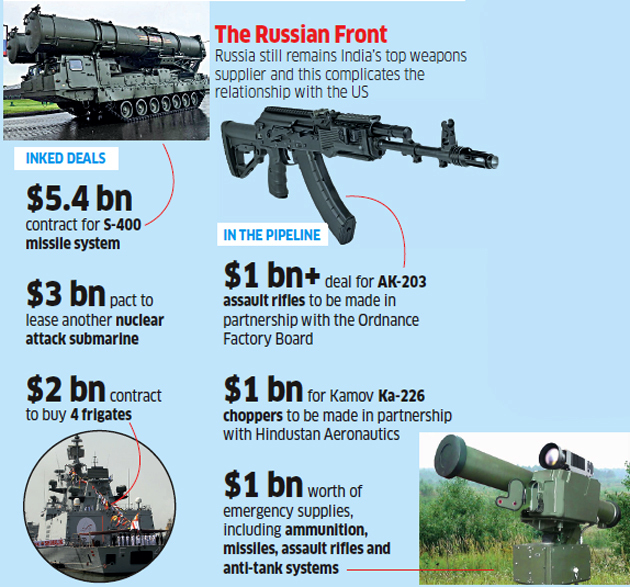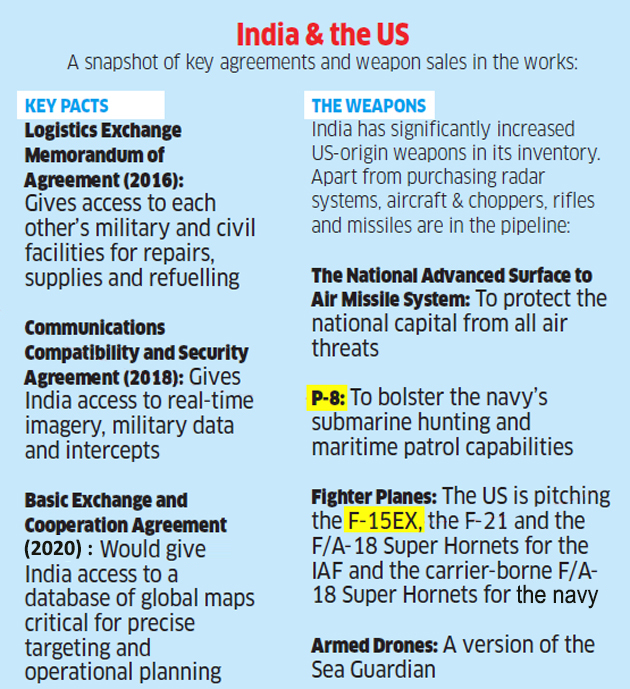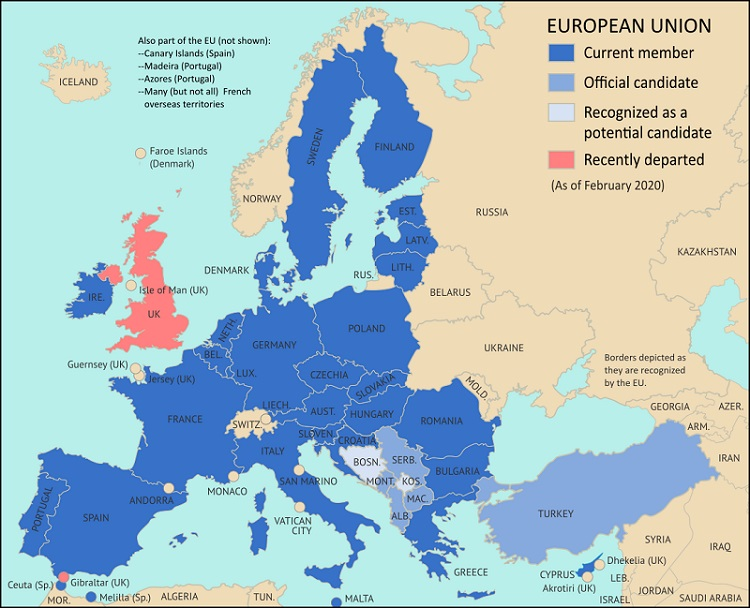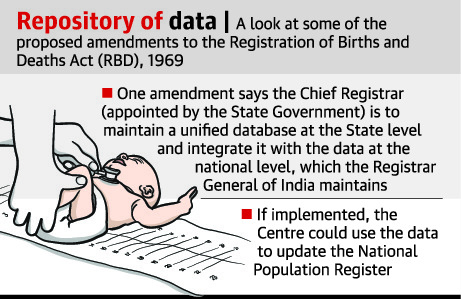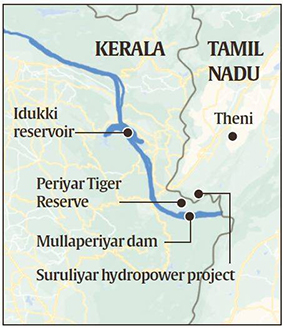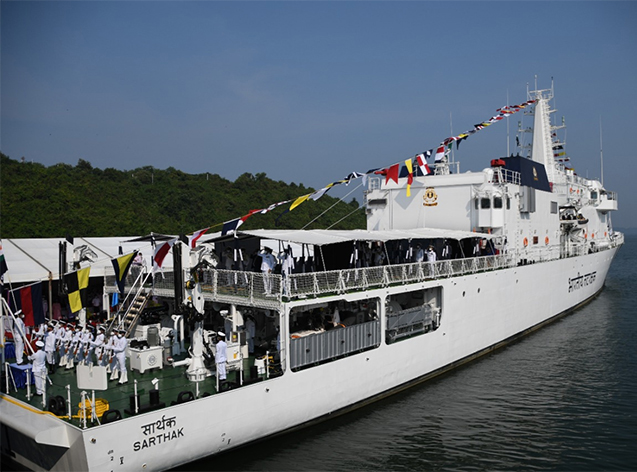Indian Military Dependence on Russian Equipments
Why in News
According to the Military Balance 2021, India's present military arsenal is heavily stocked with Russian-made or Russian-designed equipment.
- The Military Balance is the International Institute for Strategic Studies’ (global think tank) annual assessment of the military capabilities and defence economics of 171 countries worldwide.
Key Points
- About the Report:
- There has been a considerable drop in India’s dependence on arms and equipment from Russia.
- However, the Indian military cannot operate effectively without Russian-supplied equipment and will continue to rely on its weapons systems in the near and middle terms.
- The report is crucial in the pretext of the US administration's review of Countering America’s Adversaries Through Sanctions Act (CAATSA).
- The CAATSA seeks to impose sanctions against the country buying military arms from Russia.
- India’s plan to purchase Russian-made S-400 air defense systems, which could trigger US sanctions under Section 231 of CAATSA.
- There has been a considerable drop in India’s dependence on arms and equipment from Russia.
- India-Russia’s Military Relations:
- Indian Dependence: According to Stockholm International Peace Research Institute (SIPRI), since 2010, Russia has been the source of nearly two-thirds (62%) of all Indian arms imports.
- Further, India has been the largest Russian arms importer, accounting for nearly one-third (32%) of all Russian arms exports.
- Favourable Russian Military Exports to India: Much of Russia’s influence in India comes through its willingness to provide weapons systems and technologies that no other country will export to India.
- The US only provides non-lethal defence technology like C-130j Super Hercules, C-13 Globemaster, P-8i Poseidon etc, while Russia provides high-end technology like Brahmos supersonic missile, S-400 anti-missile system.
- Russia also continues to offer advanced weapons platforms at relatively attractive rates.
- Army Cooperation: Around 10,000 pieces of military hardware are procured from Russia.
- The Indian Army’s main battle tank force is composed predominantly of Russian T-72M1 (66%) and T-90S (30%).
- India is negotiating on the price of AK103 rifles for Make in India.
- Naval Cooperation: Indian Navy’s sole operational aircraft carrier is a refurbished Soviet-era ship (INS Vikramaditya). The Navy’s fighter fleet comprises 43 MiG-29K.
- Four of the Navy’s 10 guided-missile destroyers are Russian Kashin class, and six of its 17 frigates are Russian Talwar class.
- The Navy’s sole nuclear-powered submarine is on lease from Russia, and eight of the service’s 14 other submarines are Russian-origin Kilo class.
- Air Force Cooperation: The Indian Air Force’s 667-plane FGA (Fighter Ground Attack) fleet is 71% Russian-origin (39% Su-30s (Sukhoi), 22% MiG-21s, 9% MiG-29s).
- All six of the service’s air tankers are Russian-made Il-78s.
- Missile Cooperation: The country’s only nuclear-capable supersonic cruise missile, BrahMos, is produced by a joint venture with Russia.
- The S-400 Air Defence Missile Systems is expected to be delivered by 2021.
- Military Exercises: India and Russia conduct the INDRA series of military exercises, which began in 2003. However, the first joint Tri-Services Exercise was conducted in 2017.
- Indian Dependence: According to Stockholm International Peace Research Institute (SIPRI), since 2010, Russia has been the source of nearly two-thirds (62%) of all Indian arms imports.
Way Forward
- Russia’s closeness with China and Pakistan has raised concerns for India. However, this closeness is tactical, mainly induced due to western sanctions, whereas Russia-India partnership is strategic.
- This is because Russia always saw India as a balancer against growing Chinese assertiveness.
- India can widen its procurement basket and can remain close to Russia for its strategic programmes and joint development of weapon systems.
- Thus, decoupling India’s choice of arms suppliers from the strategic relationship it has forged with the US is the way ahead.
US’ CAATSA and Russia’s S-400
Why in News
The US lawmakers continue to voice their support for a sanctions waiver from Countering America’s Adversaries Through Sanctions Act (CAATSA) for India.
- In October 2018, India signed a 5.43 billion USD deal with Russia for the S-400 Triumf missile system despite objections from the US and the threat of sanctions under CAATSA. India is likely to begin taking delivery of the S-400 missile defence system from Russia in November 2021.
Key Points
- About the US’ CAATSA:
- US Law: It is a US federal law enacted in 2017. The Act empowers the US President to impose at least five of the 12 listed sanctions on persons engaged in a “significant transaction” with Russian defence and intelligence sectors.
- Its “ultimate goal”, “is to prevent revenue from flowing to the Russian Government.
- Besides Russia, CAATSA is aimed at enforcing sanctions against Iran and North Korea.
- Types of Sanctions: The CAATSA contains 12 types of sanctions. There are only two sanctions that may impact either India-Russia relations or India-US relations.
- Prohibition of Banking transactions: The first of these, which is likely to have an impact on India-Russia relations, is the “Prohibition of Banking transactions”.
- This would mean difficulties for India in making payments in US Dollars to Russia for the purchase of the S-400 systems.
- Export Sanction: The second sanction will have greater consequences for India-US relations.
- This is the “export sanction” which has the potential to completely derail the India-US Strategic and Defence partnership, as it will deny the license for, and export of, any items controlled by the US.
- Prohibition of Banking transactions: The first of these, which is likely to have an impact on India-Russia relations, is the “Prohibition of Banking transactions”.
- Waiver Criteria: The US President was given the authority in 2018 to waive CAATSA sanctions on a case-by-case basis.
- US Law: It is a US federal law enacted in 2017. The Act empowers the US President to impose at least five of the 12 listed sanctions on persons engaged in a “significant transaction” with Russian defence and intelligence sectors.
- Russia’s S-400 Triumf Missile System:
- About:
- It is a mobile, Surface-to-Air Missile system (SAM) designed by Russia.
- It is the most dangerous operationally deployed Modern Long-Range SAM (MLR SAM) in the world, considered much ahead of the US-developed Terminal High Altitude Area Defense system (THAAD).
- It integrates a multifunction radar, autonomous detection and targeting systems, anti-aircraft missile systems, launchers, and command and control centre.
- It is capable of firing three types of missiles to create a layered defence.
- The system can engage all types of aerial targets including aircraft, unmanned aerial vehicles (UAV) and ballistic and cruise missiles within the range of 400km, at an altitude of up to 30km.
- The system can track 100 airborne targets and engage six of them simultaneously.
- Significance for India:
- From India’s point of view, China is also buying the system. In 2015, China signed an agreement with Russia to purchase six battalions of the system. Its delivery began in January 2018.
- China’s acquisition of the S-400 system has been viewed as a “game changer” in the region. However, its effectiveness against India is limited.
- India’s acquisition is crucial to counter attacks in a two-front war, including even high-end F-35 US fighter aircraft.
- From India’s point of view, China is also buying the system. In 2015, China signed an agreement with Russia to purchase six battalions of the system. Its delivery began in January 2018.
- About:
India-US Defence Cooperation
- Both countries signed the ‘New Framework for India-US Defense Relations’ in 2005, which was further updated for 10 years in 2015.
- The USA recognised India as a Major Defence Partner in 2016.
- The designation allows India to buy more advanced and sensitive technologies from America at par with that of the US's closest allies and partners.
- India and US inked important defence pacts in the last few years and also formalised the four nation alliance of QUAD (India, US, Japan and Australia).
- Four Foundational Defence Agreements:
- Basic Exchange and Cooperation Agreement for Geospatial Intelligence (BECA).
- General Security of Military Information Agreement (GSOMIA).
- Logistics Exchange Memorandum of Agreement (LEMOA).
- Communication Compatibility and Security Agreement (COMCASA).
- US Military Equipment in India: Indian Air Force’s C-17 heavy-lifters, Apache attack helicopters and C-130J special operations aircraft, India’s Navy’s P-8I surveillance aircraft and the Indian Army’s M-777 ultra-light howitzers.
- Defence Exercises:
- Malabar exercise (Quadrilateral naval exercise of India, USA, Japan and Australia) , Yudh Abhyas (Army); Cope India (Air Force); Vajra Prahar (Special Forces).
Way Forward
- Russia always saw India as a balancer that's why Russia facilitated India's inclusion into Shanghai Cooperation Organisation (SCO) and formation of Russia-India-China (RIC) grouping.
- India today is in a unique position where it has a favourable relation with all great powers, and she must leverage this position to help in building a peaceful world order.
- The defence procurement for India has become significant amid deadly clashes with China on Line of Actual Control (LAC). Further, Russia is an all weather defence partner of India.
- However, India needs to balance its relation with both Russia and USA, so that its national interest is not compromised.
- It needs to develop closer ties with the United States, which could balance any moves towards a strategic partnership between China and Russia.
Renegotiation of BTIA: India-EU
Why in News
Recently, government officials have revealed that India and the European Union (EU) are set to resume negotiations for a Bilateral Trade and Investment Agreement (BTIA). The BTIA talks have been suspended since 2013.
- However, at India-EU Leaders’ Meeting earlier this year, both countries agreed to relaunch free trade negotiations for the BTIA and also adopted a Connectivity Partnership.
Key Points
- About BTIA:
- Background: India and EU had launched talks for having a wide-ranging Free Trade Agreement (FTA), officially called broad-based BTIA, long ago in 2007.
- The BTIA was proposed to encompass trade in goods, services and investments.
- However, the talks stalled in 2013 over differences on market access and movement of professionals.
- Scope: The EU was India’s largest trading partner in goods 2019-20, ahead of China and the US, with total trade close to USD 90 billion.
- With the signing of the BTIA , India and the EU expect to promote bilateral trade by removing barriers to trade in goods and services and investment across all sectors of the economy.
- Challenges: Pursuit of self-reliance has been accelerated by the Covid-19 crisis under the Atmanirbhar Bharat Mission. This is perceived by the European Union as India's “protectionist stance”.
- India may find it difficult to meet the sustainable standards in labour and environment on which the EU now lays greater emphasis.
- Significance: India seeks to signal that it means business and is not averse to signing trade agreements after it opted out of the Regional Comprehensive Economic Partnership (RCEP) at the last moment.
- The EU, in turn, wants to diversify its value chain away from China to India and, hence, there is interest on its part also to have a trade agreement with India.
- Background: India and EU had launched talks for having a wide-ranging Free Trade Agreement (FTA), officially called broad-based BTIA, long ago in 2007.
- Connectivity Roadmap:
- More than Physical Connectivity: It is an ambitious and comprehensive connectivity project, which not only focuses on physical infrastructure but also envisages enhancing digital, energy, transport and people-to-people connectivity.
- Components: India-EU connectivity roadmap covers three main areas — trade and investment, science and technology and Sustainable Development Goals (SDG).
- Regional and Multi Stakeholder Approach: The focus areas were connectivity within the country, building connectivity with Europe and in that process work with other countries in South Asia and Info-Pacific.
- It will catalyse private and public financing for connectivity projects.
- Counterfoil to BRI: The report titled India-EU Connectivity: Partnership for Development, Demand and Democracy’ underlines that the connectivity road map indirectly seeks to counterfoil China’s Belt and Road Initiative (BRI).
- As it stressed on principles like democracy, rule of law, inclusiveness and transparency and avoiding debt trap.
Way Forward
- Geo-Economic Cooperation: India can pursue EU countries to engage in Indo-pacific narrative, geo-economically if not from security prism.
- It can mobilise massive economic resources for sustainable development of regional infrastructure, wield political influence and leverage its significant soft power to shape the Indo-Pacific discourse.
- Finalisation of Indo-EU BTIA Treaty: India and the European Union have been negotiating a free trade deal, but it is pending since 2007.
- Therefore, for closer convergence between India and the EU, both should engage in finalisation of the trade deal as soon as possible.
- Collaborating With Important Players: French President Emmanuel Macron’s visit to India in early 2018 unveiled an expansive framework for revitalising the strategic partnership.
- India’s partnership with France now has a strong regional anchor in the Indo-Pacific narrative.
- India is also engaged in negotiations for a trade pact with the UK.
G20 Climate Risk Atlas
Why in News
Recently, a report named G20 Climate Risk Atlas from the Euro-Mediterranean Center on Climate Change (CMCC) has said that G20 (Group of 20) countries including the wealthiest like the US, European countries, and Australia will bear extreme impacts of climate change over the coming years.
- The first study of its kind, it provides climate scenarios, information, data and future changes in climate across the G20 countries.
- The report came two days ahead of the G20 summit in Rome at the end of October 2021.
Key Points
- Impact on G20 Countries:
- Heatwaves:
- Heatwaves could last at least ten times longer in all G20 countries, with heatwaves in Argentina, Brazil and Indonesia lasting over 60 times longer by 2050.
- In Australia, bushfires, coastal floods and hurricanes could raise insurance costs and reduce property values by 611 billion Australian Dollars by 2050.
- Heatwaves could last at least ten times longer in all G20 countries, with heatwaves in Argentina, Brazil and Indonesia lasting over 60 times longer by 2050.
- GDP Loss:
- GDP (Gross Domestic product) losses due to climate damage in G20 countries increase each year, rising to at least 4% annually by 2050. This can reach over 8% by 2100, equivalent to twice the bloc’s economic losses from Covid-19.
- Some countries will be even worse hit, such as Canada, which could see at least a 4% decrease in its GDP by 2050 and over 13% by 2100.
- GDP (Gross Domestic product) losses due to climate damage in G20 countries increase each year, rising to at least 4% annually by 2050. This can reach over 8% by 2100, equivalent to twice the bloc’s economic losses from Covid-19.
- Sea Level Rise:
- The sea level rise could wreck coastal infrastructure within 30 years, with Japan set to lose 404 billion euro and South Africa 815 million euro by 2050, on a high emissions pathway.
- Flooding
- Expected annual damages from riverine flooding by 2050 are estimated to be 376.4 billion Euro under a low emissions scenario and rise to 585.6 billion EUR under a high emissions scenario.
- Heatwaves:
- Impact on India:
- Emission Scenarios:
- Low Emission (emissions lower than in present):
- Projected temperature variations will remain contained under 1.5 degree celsius , both by 2050 and 2100.
- Medium Emission (same as present):
- Between 2036 and 2065, the maximum temperature of the warmest month in India could rise by at least 1.2 degree celsius in a medium emission pathway.
- High Emission (higher than present):
- By 2050 under a high emission scenario average temperature could rise to 2 degree celsius.
- Low Emission (emissions lower than in present):
- Rainfall:
- Annual rainfall is likely to record a steep increase by 2050 with an 8% to 19.3% increase in all emission scenarios.
- Economic Impact:
- In India, declines in rice and wheat yields due to climate change could lead to economic losses between 43 and 81 billion EUR (or 1.8-3.4% of (GDP) by 2050.
- Water demand for agriculture is likely to rise around about 29% by 2050 – meaning yield losses are likely to be underestimated.
- Heatwaves:
- Heatwaves in India will last 25 times longer by 2036-2065 if emissions are high (4°C), over five times longer if global temperature rise is constrained to about 2°C, and one and a half times longer if emissions are very low and temperature rise only reaches 1.5°C.
- Agricultural Drought:
- On a pathway to 4°C global heating, agricultural drought will become 48% more frequent by 2036-2065.
- On a 2°C pathway (the maximum temperature agreed by the Paris Agreement) this drops to 20% more frequent, and constraining temperature rise to 1.5°C (the aspirational goal of the Paris Agreement), agricultural drought will still be 13% more frequent.
- Flooding:
- Under 18 million Indians could be at risk of river flooding by 2050 if emissions are high, compared to 1.3 million today.
- Labour:
- Total labour is expected to decline by 13.4% under a low emissions scenario by 2050 due to the increase in heat, and by 24% under a medium emissions scenario by 2080.
- Food Security:
- In India, declines in rice and wheat production could spark economic losses of up to Euros 81 billion by 2050 and a loss of 15% of farmers’ incomes by 2100.
- Emission Scenarios:
Way Forward
- The window to act is closing fast. As the G20 countries incentivize economic recovery from Covid-19 and prepare climate plans ahead of COP26, they face an urgent choice to protect the global economy and make a rapid transition to a low-carbon future; or derail the global economy by pursuing polluting policies.
- It's time for the G20 to make its economic agenda a climate agenda. Rapid action is needed to tackle emissions and adapt to climate change will limit the severe impacts of climate change.
- G20 governments should listen to science and put the world on a path to a better, fairer and more stable future.
Deputy Speaker Election
Why in News
Recently, an MLA from UP was elected Deputy Speaker of the Uttar Pradesh Assembly.
- Article 93 of the Constitution provides for the election of both the Speaker and the Deputy Speaker of the Lok Sabha.
- Article 178 contains the corresponding position for Speaker and Deputy Speaker of the Legislative Assembly of a state.
Key Points
- Deputy Speaker:
- Elected By:
- The Deputy Speaker is elected by the Lok Sabha from amongst its members right after the election of the Speaker has taken place.
- The date of election of the Deputy Speaker is fixed by the Speaker (date of election of the Speaker is fixed by the President).
- The institutions of Speaker and Deputy Speaker originated in India in 1921 under the provisions of the Government of India Act of 1919 (Montague-Chelmsford Reforms).
- At that time, the Speaker and the Deputy Speaker were called the President and Deputy President respectively and the same nomenclature continued till 1947.
- Time Frame & Rules of Election:
- The practice in both Lok Sabha and the State Legislative Assemblies has been to elect the Speaker during the (mostly short) first session of the new House usually on the third day after oath-taking and affirmations take place over the first two days.
- The election of the Deputy Speaker usually takes place in the second session, even though there is no bar on having this election too in the first session of the new Lok Sabha/Assembly.
- But the election of Deputy Speaker is generally not delayed beyond the second session without genuine and unavoidable constraints.
- In Lok Sabha, the election of Deputy Speaker is governed by Rule 8 of The Rules of Procedure and Conduct of Business in Lok Sabha.
- Once elected, the Deputy Speaker usually continues in office until the dissolution of the House.
- Term of Office and Removal:
- Like the Speaker, the Deputy Speaker remains in office usually during the life of the Lok Sabha (5 years).
- The Deputy Speaker may vacate his/her office earlier in any of the following three cases:
- If he ceases to be a member of the Lok Sabha.
- If he resigns by writing to the Speaker.
- If he is removed by a resolution passed by a majority of all the then members of the Lok Sabha.
- Such a resolution can be moved only after giving 14 days’ advance notice.
- In the case of the State Assembly, the removal process is the same as that of the Speaker and Deputy Speaker of the Lok Sabha.
- Responsibilities and Powers (Deputy Speaker of the Lok Sabha):
- Under Article 95 of the constitution, the Deputy Speaker performs the duties of the Speaker’s office when it is vacant.
- He/She also acts as the Speaker when the latter is absent from the sitting of the House.
- He/She also presides over the joint sitting of both the Houses of Parliament, in case the Speaker is absent from such a sitting.
- The Deputy Speaker has one special privilege, that is, whenever he/she is appointed as a member of a parliamentary committee, he/she automatically becomes its chairman.
- Under Article 95 of the constitution, the Deputy Speaker performs the duties of the Speaker’s office when it is vacant.
- Elected By:
- Deputy Speaker and Tenth Schedule (Exception):
- Para 5 of the Tenth Schedule (commonly known as the anti-defection law) says that a person who has been elected Speaker/ Deputy Speaker shall not be disqualified:
- If he, by reason of his election to that office, voluntarily gives up the membership of the political party to which he belonged immediately before such election,
- And does not, so long as he continues to hold such office thereafter, rejoin that political party or become a member of another political party.
- This exemption applies to the Rajya Sabha Deputy Chairman, Chairman/ Deputy Chairman of a state Legislative Council, and Speaker/ Deputy Speaker of a state Legislative Assembly as well.
- Para 5 of the Tenth Schedule (commonly known as the anti-defection law) says that a person who has been elected Speaker/ Deputy Speaker shall not be disqualified:
Registration of Births and Deaths Act (RBD), 1969
Why in News
Recently, the Centre has proposed amendments to the Registration of Births and Deaths Act (RBD), 1969.
- It will enable it to “maintain the database of registered birth and deaths at the national level”.
Key Points
- Registration of Birth and Death:
- Registration of Births and Deaths in India is mandatory with the enactment of Registration of Births and Deaths (RBD), Act 1969 and is done as per the place of occurrence of the event.
- With a view to simplify the provisions of various sections of the existing RBD Act, 1969 and to make it people friendly, the amendment has been proposed.
- Proposed Amendments:
- Chief Registrar to maintain Unified Data:
- The Chief Registrar (appointed by the States) would maintain a unified database at the State level and integrate it with the data at the “national level,” maintained by the Registrar General of India (RGI) (under the Ministry of Home Affairs) .
- Presently, the registration of births and deaths is done by the local registrar appointed by States.
- The Chief Registrar (appointed by the States) would maintain a unified database at the State level and integrate it with the data at the “national level,” maintained by the Registrar General of India (RGI) (under the Ministry of Home Affairs) .
- Special Sub-Registrars:
- The appointment of “Special Sub-Registrars, in the event of disaster, with any or all of his powers and duties for on the spot registration of deaths and issuance of extract thereof, as may be prescribed.”
- Chief Registrar to maintain Unified Data:
- Expected Use of the Data:
- To update the National Population Register (Citizenship Act, 1955) and the electoral register (Registration of Electors Rules, 1960), and Aadhaar (Aadhaar Act, 2016), ration card (National Food Security Act, 2013), passport (Passport Act) and driving licence databases (Motor Vehicles (Amendment) Act, 2019).
- The NPR already has a database of 119 crore residents and under the Citizenship Rules, 2003, it is the first step towards the creation of the National Register of Citizens (NRC).
- The NPR update and the first phase of Census will be conducted simultaneously by the RGI.
- To update the National Population Register (Citizenship Act, 1955) and the electoral register (Registration of Electors Rules, 1960), and Aadhaar (Aadhaar Act, 2016), ration card (National Food Security Act, 2013), passport (Passport Act) and driving licence databases (Motor Vehicles (Amendment) Act, 2019).
Water Level in Mullaperiyar Dam
Why in News
Recently, the Supreme Court has directed the Supervisory Committee to take an immediate and firm decision on the maximum water level that can be maintained at Mullaperiyar dam amidst torrential rains in Kerala.
- The Ministry of Jal Shakti has constituted a three-member Supervisory Committee to settle the issue of Mullaperiyar dam between Kerala and Tamil Nadu.
Key Points
- About:
- Centre of a Decades-old Dispute:
- For Kerala, where it is situated, the dam presents a threat to lakhs living downstream,
- For Tamil Nadu, which controls the dam, the water it provides is the lifeline of people in five districts.
- Reasons for Recent Revival of the Dispute:
- Recently, heavy rains have increased water flow in Mullaperiyar dam. The excess water from Mullaperiyar can flow to downstream Idukki reservoir, which can lead to floods.
- The SC in 2018 had agreed that the water level in the Mullaperiyar reservoir should be maintained two or three feet below the permissible limit of 142 feet as an immediate precaution to guard against floods or other disasters.
- Centre of a Decades-old Dispute:
- Mullaperiyar Dam:
- It is located on the confluence of the Mullayar and Periyar rivers in Kerala’s Idukki district.
- The reservoir is within the Periyar Tiger Reserve.
- It is operated and maintained by Tamil Nadu for meeting the drinking water and irrigation requirements of five of its southern districts.
- According to a 999-year lease agreement made during British rule the operational rights were handed over to Tamil Nadu.
- The water diverted from the reservoir is first used for power generation in lower Periyar (by Tamil Nadu) before flowing into the Suruliyar, a tributary of Vaigai river, and then for irrigating nearly 2.08 lakh hectares in Theni and four other districts farther away.
- It is located on the confluence of the Mullayar and Periyar rivers in Kerala’s Idukki district.
Periyar River
- The Periyar River is the longest river in the state of Kerala with a length of 244 km.
- It is also known as ‘Lifeline of Kerala’ as it is one of the few perennial rivers in the state.
- Periyar River originates from Sivagiri hills of Western Ghats, in Tamil Nadu and flows through the Periyar National Park.
- The main tributaries of Periyar are Muthirapuzha, Mullayar, Cheruthoni, Perinjankutti.
Idukki Dam
- It is located in Kerala (168.91 m). The dam stands between the two mountains – Kuravanmala (839 m) and Kurathimala (925 m).
- It is one of the highest arch dams in Asia and third tallest arch dam.
- It is built on the Periyar River, in the ravine between the Kuravan and Kurathi Hills in Kerala.
- It was constructed and is owned by the Kerala State Electricity Board. It supports a 780 MW hydroelectric power station.
OPV Sarthak
Why in News
Recently, an Offshore Patrol Vessel (OPV), Indian Coast Guard Ship (ICGS) Sarthak has been commissioned and dedicated to the nation at Goa by the Indian Coast Guard.
Key Points
- It is a 105-meter-long ship displacing 2,450 tons and is propelled by two 9,100 kilowatt diesel engines designed to attain a maximum speed of 26 knots.
- It is 4th in the series of five OPVs. And will significantly boost the maritime safety and security of the nation.
- OPVs are long-range surface ships, capable of operation in maritime zones of India, including island territories with helicopter operation capabilities.
- Their roles include coastal and offshore patrolling, policing maritime zones of India, control and surveillance, anti-smuggling and anti-piracy operations with limited wartime roles.
- Development:
- It has been designed & built indigenously by M/s Goa Shipyard Limited (GSL) in line with the government’s vision of ‘Make in India’.
- It has about 70% indigenous content, thus providing the necessary fillip to the Indian shipbuilding industry and a giant leap towards achieving ‘Atmanirbar Bharat’.
- It has been designed & built indigenously by M/s Goa Shipyard Limited (GSL) in line with the government’s vision of ‘Make in India’.
- Features:
- It has state-of-the-art Navigation and Communication equipment, sensors and machinery.
- It is capable of carrying a twin-engine helicopter, four high speed boats and one inflatable boat for swift boarding and Search & Rescue operations.
- It is also capable of carrying limited pollution response equipment to undertake oil spill pollution response at sea.
- Utility:
- It will be deployed extensively for Exclusive Economic Zone (EEZ) surveillance, Coastal Security and other duties as enshrined in the Coast Guard charter of duties, to safeguard the maritime interests of the Nation.
- Other OPVs:
Indian Coast Guard
- It is an Armed Force, Search and Rescue and Maritime Law Enforcement agency under the Ministry of Defence. It is headquartered in New Delhi.
- It was established in August 1978 by the Coast Guard Act, 1978 as an independent Armed force of India.
- The concept of forming ICG came into being after the 1971 war. The blueprint for a multidimensional Coast Guard was conceived by the visionary Rustamji Committee.
- It has jurisdiction over the territorial waters of India including contiguous zone and Exclusive Economic Zone (EEZ).
- It is responsible for marine environment protection in maritime zones of India and is coordinating authority for response to oil spills in Indian waters.
Assistance to Disabled Persons Scheme
Why in News
Recently, a Samajik Adhikarita Shivir(social empowerment camp) for distribution of aids and assistive devices to Divyangjan under the ADIP (Assistance to Disabled Persons) Scheme was organised in Punjab.
- Divyangjan or Divyang: Earlier, in 2015 the Prime Minister decided that persons with disabilities should no longer be referred to as disabled persons or viklang (someone with non-functional body parts) instead they will be referred to as Divyangjan or Divyang (one with a divine body).
Key Points
- About:
- Ministry:
- Ministry of Social Justice and Empowerment is the Nodal ministry
- It has been in operation since 1981.
- Definition:
- The scheme follows the definitions of various types of disabilities as given in the Persons with Disabilities (Equal Opportunities, Protection of Rights and Full Participation) (PWD) Act 1995.
- The PWD Act was replaced by the Right of Persons with Disabilities Act 2016.
- The scheme follows the definitions of various types of disabilities as given in the Persons with Disabilities (Equal Opportunities, Protection of Rights and Full Participation) (PWD) Act 1995.
- Objective:
- To assist the needy disabled persons in procuring durable, sophisticated and scientifically manufactured, modern, standard aids and appliances that can promote their physical, social and psychological rehabilitation by reducing the effects of disabilities and enhancing their economic potential.
- Grants:
- Grants-in-aid are released to various implementing agencies (Artificial Limbs Manufacturing Corporation of India, National Institutes, Composite Regional Centres, District Disability Rehabilitation Centres, State Handicapped Development Corporations, Non-governmental Organizations (NGOs) , etc.) for purchase and distribution of aids and assistive devices.
- Assistance:
- Aids/appliances which do not cost more than Rs. 10,000 are covered under the Scheme for single disability.
- However, in some cases the limit would be raised to Rs.12,000. In the case of multiple disabilities, the limit will apply to individual items separately in case more than one aid/appliance is required.
- Full cost of aid/appliance is provided if the income is up to Rs. 15,000 per month and 50% of the cost of aid/appliance is provided if the income is between Rs. 15,001 to Rs. 20,000 per month.
- Ministry:
- Other Related Initiatives:
- Initiatives for Mental Health:
Indian Telegraph Right of Way (Amendment) Rules, 2021
Why in News
Recently, the Central Government has notified the Indian Telegraph Right of Way (Amendment) Rules, 2021.
- The rule aims to incorporate the provisions related to nominal one-time compensation and uniform procedure for establishment of Overground Telegraph Line in the Indian Telegraph Right of Way Rules, 2016.
Key Points
- About:
- Compensation: The amount of one-time compensation for establishment of an overground telegraph line will be a maximum one thousand rupees per kilometre.
- Right of Way (RoW): These amendments will ease RoW related permission procedures for establishment and augmentation of digital communications infrastructure across the country.
- Earlier, the RoW Rules had covered only underground Optical Fibre Cable (OFC) and mobile towers.
- Fees: There will be no fee other than Administrative fee and Restoration charges for establishing, maintaining, transferring or shifting the underground and overground telegraph infrastructure.
- Significance:
- The digital divide between rural-urban and rich-poor will be bridged, in line with the Digital India mission and BharatNet project.
- E-governance and financial inclusion will be strengthened.
- Doing business will be easy.
- Information and communication needs of citizens and enterprises will be fulfilled (including 5G).
- The dream of India’s transition to a digitally empowered economy and society will be translated into reality.

